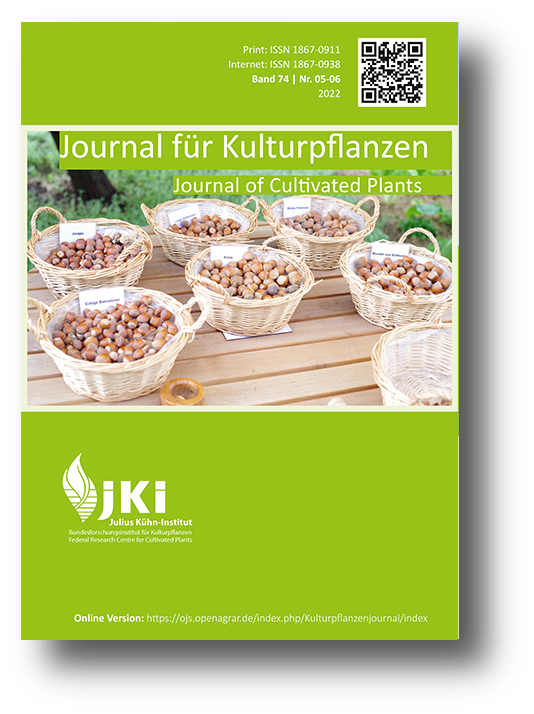Yield performance of 14 hazelnut cultivars grown for 12 years in a spindle system
DOI:
https://doi.org/10.5073/JfK.2022.05-06.05Keywords:
Corylus avellana, Corylus maxima, fruit mass, pruning, training system, cultivar evaluationAbstract
The yield performance of 14 hazelnut cultivars of different origin was compared from the second to the twelfth year after planting. The trees were trained as spindles with a planting distance of 4.5 m × 2.5 m, leading to a tree density of 800 trees per hectare. Yields >1 kg tree-1 were achieved from the fourth year after planting, and >3 kg tree-1 from the sixth year after planting. Substantial yield fluctuations between cultivars and years were observed. After reaching maturity a mean yield of 2.2 t ha-1 was achieved in the whole experimental plot, whereas the highest yielding cultivars, 'Barcelona, 'Webbs Price Cob' and 'Emoa 1' achieved average yields of 3.2 t ha-1, 2.9 t ha-1, and 2.6 t -1, respectively. The cultivars differed significantly in fruit mass and kernel mass. The varieties 'Merveille de Bollwiller' (4.0 g) and 'Corabel' (3.8 g) had the highest fruit mass. The small-fruited cultivars 'Pauetet' and 'purple-leaved filbert' had the highest mass proportion of kernel to fruit of 52% and 49%, respectively. This relation was 42% when taking into consideration the average of all cultivars and years. The mean proportion of empty nuts was 2.6% in the whole experiment, but individual cultivars reached up to 16% empty nuts in some years. 'Corabel' and 'Barcelona' had <1% empty nuts. In the 4th, 6th and 11th year after planting, averages numbers of 16, 9, or 16 root suckers per tree were counted. The time required for winter pruning in the 6th and 7th year after planting was 22 h ha-1 and 62 h ha-1, respectively. The experimental data shown in this paper demonstrate that it is possible to grow hazelnuts in a spindle system in the Central German region.
Downloads
Published
Issue
Section
License
Copyright (c) 2022 Martin Penzel, Monika Möhler

This work is licensed under a Creative Commons Attribution 4.0 International License.
The content of the journal is licensed under the Creative Commons Attribution 4.0 License. Any user is free to share and adapt (remix, transform, build upon) the content as long as the original publication is attributed (authors, title, year, journal, issue, pages).
The copyright of the published work remains with the authors. The authors grant the Journal of Cultivated Plants, the Julius Kühn-Institut and the OpenAgrar repository the non-exclusive right to distribute and exploit the work.







